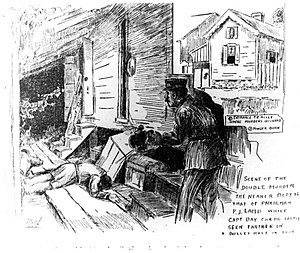Robert Charles riots
| Robert Charles riots | |
|---|---|

Sketch of the scene at Robert Charles' residence on the 2000 block of Fourth Street.
|
|
| Date | July 23 – July 28, 1900 |
| Location | New Orleans, Louisiana, United States |
| Causes | Reaction to murder of policemen |
| Methods | Rioting, looting, assault, arson, property damage, firefights, murder |
| Casualties | |
| Death(s) | 21+ |
The Robert Charles riots of 1900 in New Orleans, Louisiana were sparked after African American laborer Robert Charles fatally shot a white police officer and escaped arrest. A large manhunt for him ensued, and a white mob started rioting, attacking blacks throughout the city. The manhunt for Charles began after an altercation involving Charles, his roommate, and several New Orleans police officers on Monday, July 23, 1900, and ended when Charles was killed on Friday, July 27. A total of 28 people were killed in the conflict, including Charles, shot by a special police volunteer and his body was pumped with hundreds of bullets and beaten beyond recognition. More than 50 people were wounded in the riots, including at least 11 that had to be hospitalized.
Robert Charles (b. circa 1865) came to New Orleans from Mississippi. He was a self-educated activist for civil rights. He believed in self-defense for the African-American community and encouraged African Americans to move to Liberia to escape racial discrimination.
Louisiana was a slave society before the American Civil War, with hundreds of enslaved people working on each of numerous large cotton and sugar cane plantations, and many others in smaller groups, including in port cities such as New Orleans. Some also worked on the steamboats. At the start of the 20th century. Its population was recorded in 1900 at 730,000 'white' and 650,000 'negro' by the Twelfth Census of the United States.
Democrats had passed a new constitution with provisions that disenfranchised most African Americans through making voter registration more difficult. After that, the Democratic-dominated legislature passed eight Jim Crow laws by 1900. These included a law establishing racial segregation for public facilities, including interstate railroad cars. Plessy vs. Ferguson (1896) was a Louisiana test case of segregation on interstate railroad cars, which was appealed to the US Supreme Court. Opponents argued that federal laws and constitutional rights should apply on interstate transportation, but the Court ruled the state could establish "separate but equal" facilities. In practice, however, the "separate" facilities were seldom equal.
...
Wikipedia
